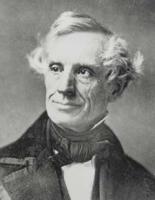Английский - простой, но очень трудный язык. Он состоит из одних иностранных слов, которые к тому же неправильно произносятся.
SAMUEL F. B. MORSE 1791-1872

Samuel F. B. Morse, the inventor of the telegraph, was born at Charlestown, Massachusetts, USA, on April 27, 1791. Morse’s family was devoutly Calvinist*, and its conservative religious beliefs influenced Morse throughout his life.
____________________
*Calvinism — Christian theology of the French church reformer John Calvin (1509-1564), the most influential in the development of the Protestant churches of the Reformed tradition.
____________________
In Yale University* Morse studied chemistry with Benjamin Silliman**.
____________________
*Yale University — the third oldest in the U.S.in New Haven. Connecticut
** Silliman, Benjamin (1779-1864) — American chemist and geologist.
____________________
From Silliman Morse learned about batteries and constructed several of his own. He graduated from Yale in 1810. But his great interest was painting. In 1813, his first and only sculpture, a figure of the dying Hercules, won critical acclaim and a gold medal in the Adelphi Society of Arts competition. Then he studied art in London. Back in the United States he opened a studio in Boston as a portrait painter. He began painting portraits of members of fashionable society. Though he considered this type of painting to be inferior to true art, he became very successful. His best known painting was the portrait of Marquis de Lafayette*.
____________________
*Lafayette, Marie-Joseph-Paul-Yves-Roch-Gilbert du Mortier de (1757-1834) — French statesman and soldier.
____________________
In 1825, he helped found the National Academy of Design in New York City, and the following year he became the first president of the institution.
In 1829, Morse sailed for Europe to study classic art in Italy. He was an artist and knew little about science. And then, at the age of 41, far out in the Atlantic Ocean, his entire life changed.
The ship sailing from France to New York on October 1, 1832 carried many passengers, among whom was Dr Jackson* who told Morse that electricity would pass through any length of wire.
____________________
*Jackson, Charles Thomas (1805-1880) American chemist and geologist, claimed to have pointed out to S. F. B. Morse the basic principles of the electric telegraph.
____________________
What is more, it would move so fast that its speed could not be measured. Morse said that if electricity could be found in any part of a long wire, he firmly believed it could be used to send messages.
This was the turning point in Morse’s life to begin to work out on a way to send messages.
Now art was a thing of the past. Morse’s unbounded energy and enthusiasm, so characteristic of genius, were now concentrated on one and only one thing — to make an instrument that could send messages instantly to any part of the world. Morse worked incessantly to make a workable telegraph. With almost no knowledge of electricity, he kept trying one thing after another, only to find that everything he tried was wrong. At the end of three years, the little money he had saved was gone. So during the next four years he taught art, because there was nothing else for him to do.
Between 1832 and 1837, he had the idea of what is called a relay. This was an electric battery on the line adding more power to send the message farther. By introducing a number of such relays, the weak current from the original batteries can be sent a long distance. By means of relays and batteries the first real telegraph was born.
Morse, now a man of 50, had spent more than six years on experiment and research. He was absolutely penniless. At this very moment he met a young man interested in the telegraph, who put some money into the invention to improve it. This was just what Morse needed. A workable telegraph was finally completed in January 1838, and introduced to the public.
But nobody was interested. It was just an impractical toy. And then, on February 3, 1843, Morse got $30,000 to start the construction work on the Washington-Baltimore telegraph line. The line was successfully installed, and on May 24, 1844, Morse sent the first message, “What hath God wrought!” He decided to put the telegraph wire underground. This worked very well on the short lines they used. But when Morse tried to do this with his long lines the electricity leaked out into the ground and the line would not work at all.
A mechanic working with Morse suggested that instead of buying the wires they should be strung among poles. The plan was successful and early in spring, on May 24, 1844, the first message ever sent over wires travelled from Washington to Baltimore in one forty-five thousandth of a second.
Morse worked out his famous alphabet or code of dots and dashes (a short buzz is called a dot, and a long buzz is called a dash).The duration of one dash equals that of three dots; the space between words is indicated by a pause that lasts as long as two dashes. The sender taps out the words in Morse code. The receiving operator at the other end of the wire takes down the code signals and translates them back into words.
This is the alphabet still used in telegraph system today.
Telegraph lines began to go up all over the world. Morse lived to be over 80 years old and did a good deal of work on the submarine cable so that messages could be telegraphed across the ocean. In 1871, the telegraph industry honoured Morse with a statue in Central Park in New York City. He died in New York on April 2, 1872.
And so Samuel Finley Breese Morse, the well-known painter, was not only the first to produce a practical telegraph, but he was the pioneer of the most widely used electrical communication in the world today, and the first man to make practical use of electric current.



